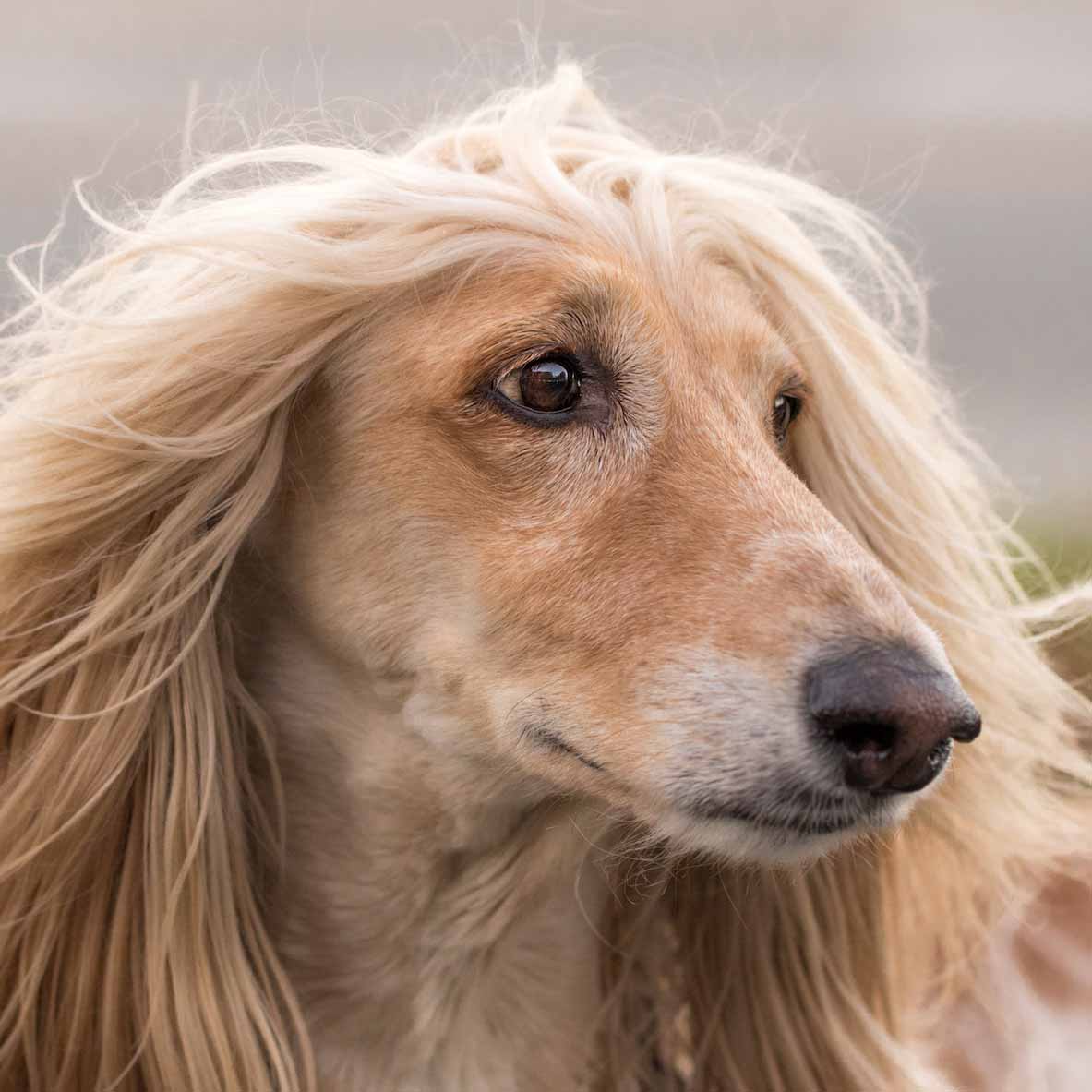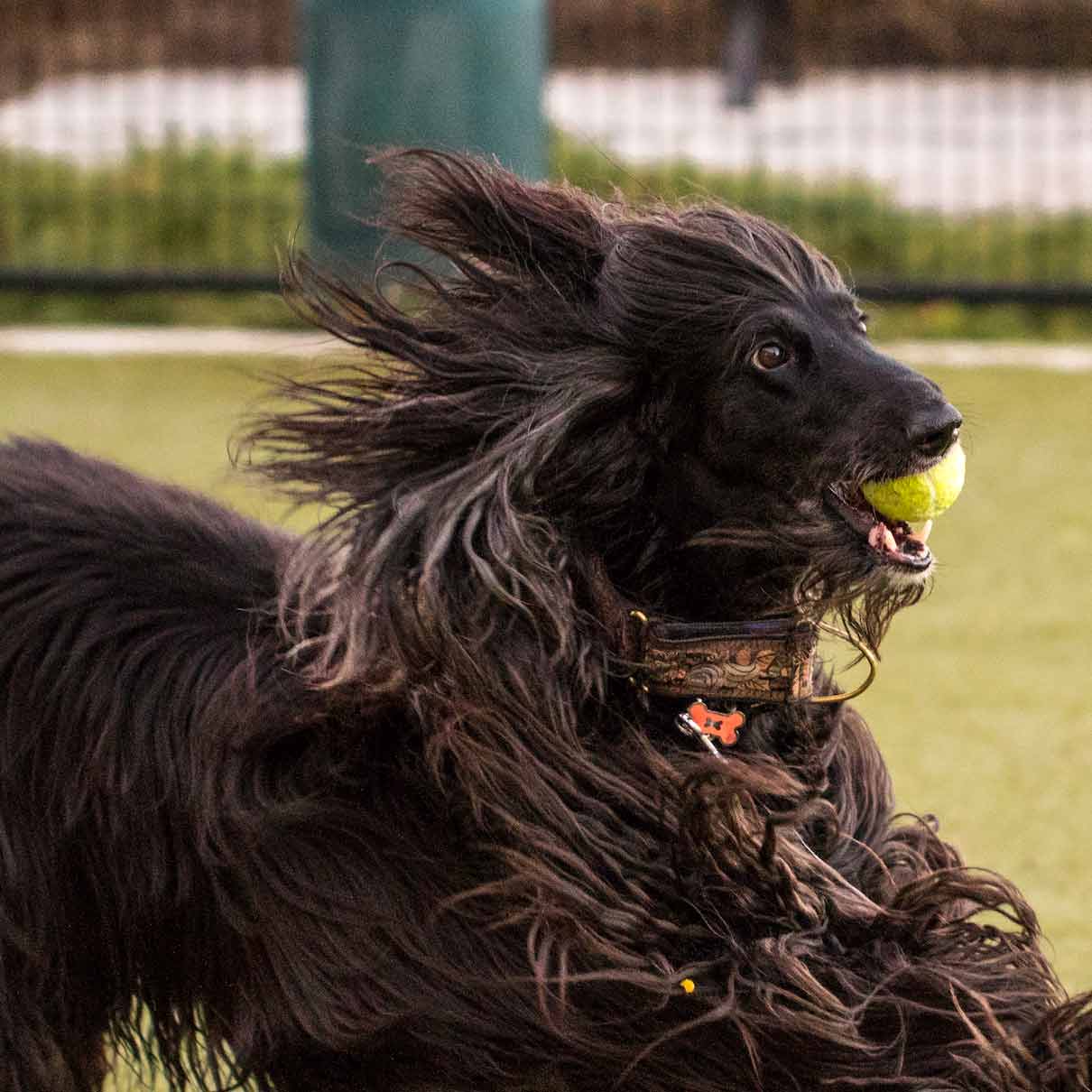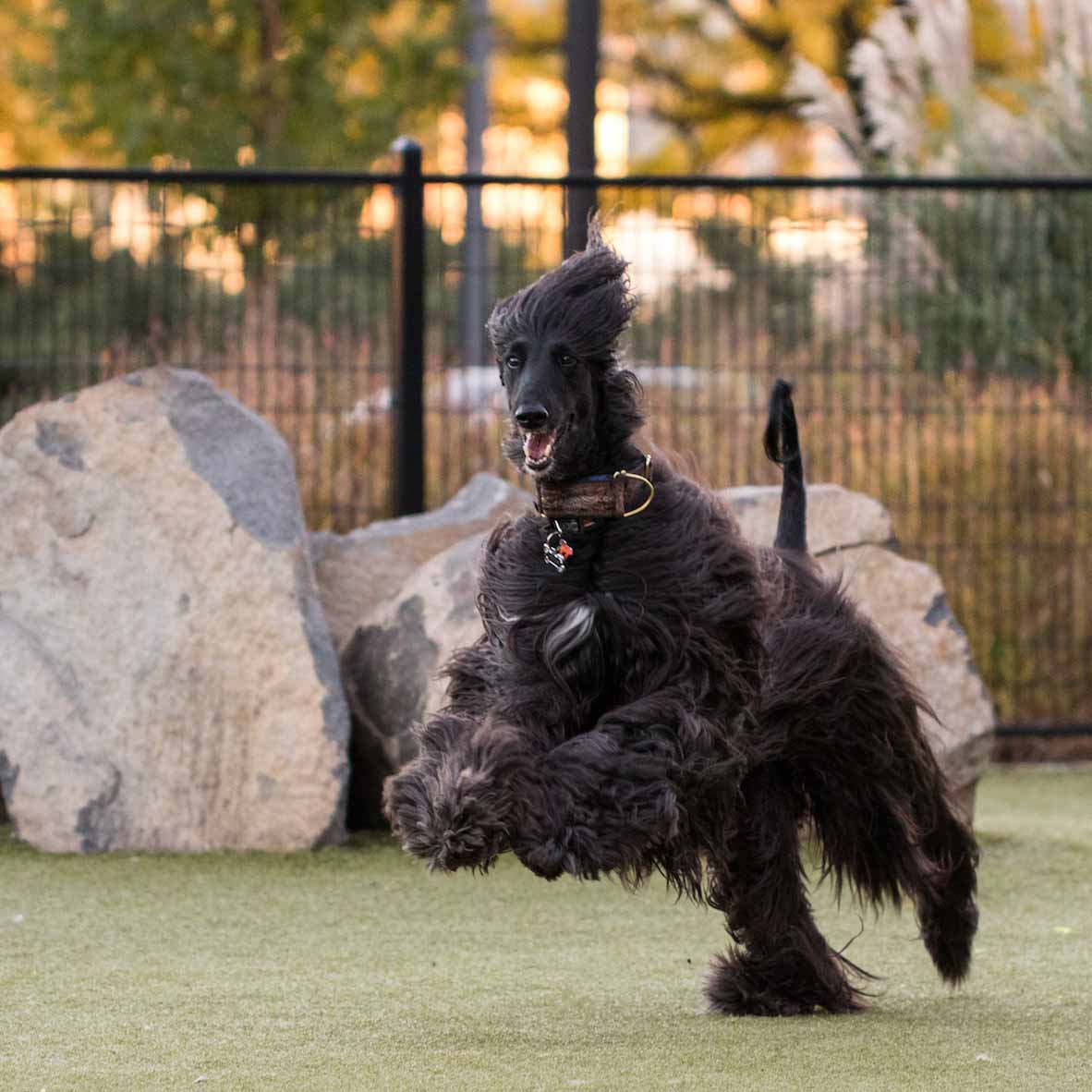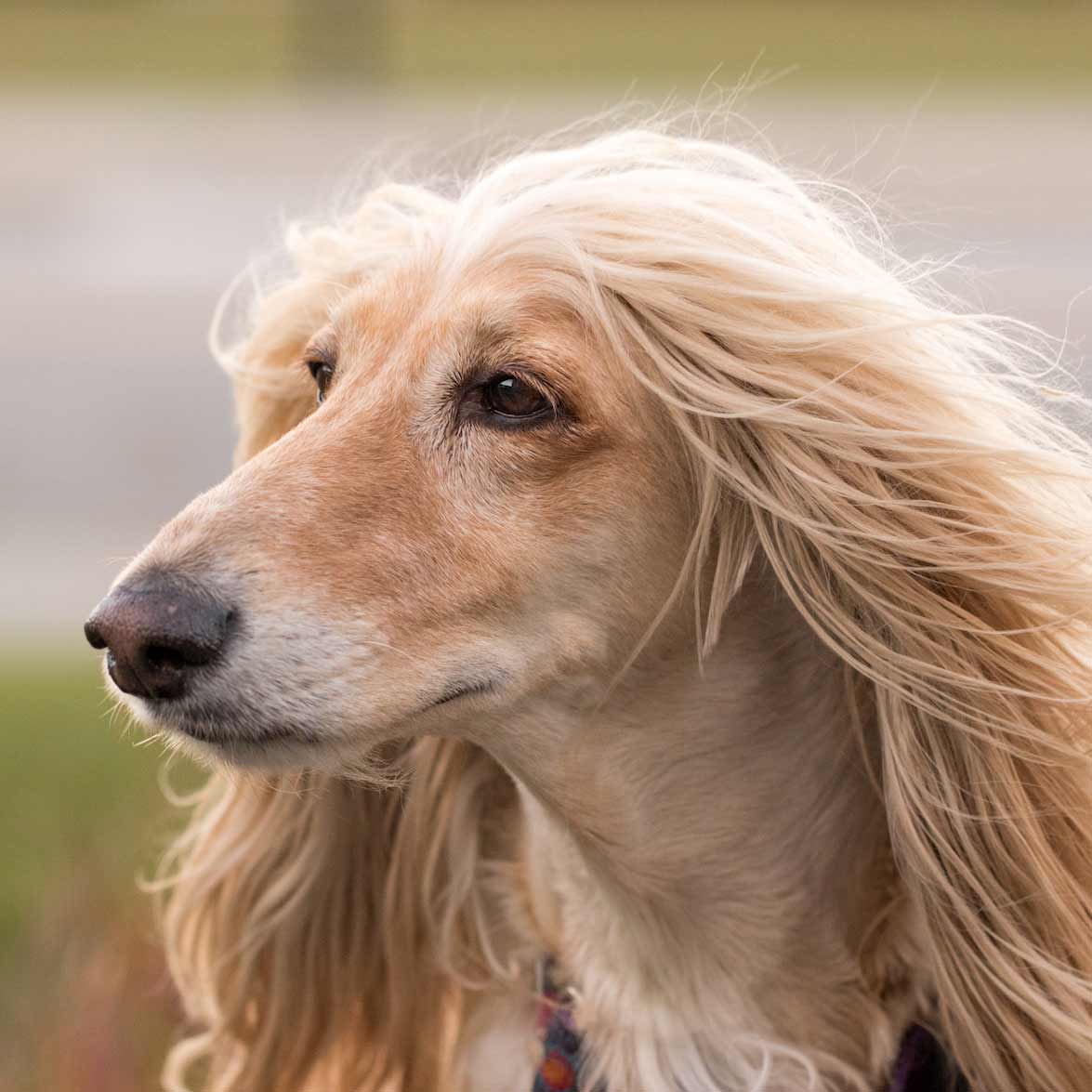Afghan Hound: Breed of the Week
Are Afghan Hounds Good City Dogs?
Photographs by Natalie Siebers
I was recently walking down the street and noticed a very attractive woman with beautiful blond hair cascading around her shoulders. I did a double take and saw a large dog walking along beside her. It was one of those clichéd cases of a dog resembling its owner. A beautiful Afghan Hound accompanied her.

Afghans are ancient, elegant dogs — The Dog of Kings — dating back thousands of years. They are so old that they are genetically closer to the first domesticated dogs than the vast majority of most modern breeds. There are Egyptian papyrus scrolls dating back 4,000 years describing the Afghan. The breeds’ origin is a bit murky, but the modern Afghan Hound hails from Afghanistan. They made their way to Britain in the 1800s. By the early-to-mid 20th century they were recognized by all the major kennel clubs in the English-speaking world.
The Afghan is a product of its environment. They were originally bred as sight hounds to hunt the large prey that inhabited the harsh regions of Central and South Asia. Their long silky coats were designed to protect them during cold nights in the Afghani Mountains. Underneath that coat is a tall, sleek body. Males stand about 27 inches at the shoulder and weigh about 60 pounds.
The Afghan comes in a variety of colors: black, blue, silver, red, and white silver. Some color combinations like silver and black are acceptable American Kennel Club colors as well.

Afghan Hounds have had some notable owners over the years. Zeppo Marx of the Marx Brothers was one of the first to bring an Afghan to the United States. Pablo Picasso was the proud owner of an Afghan named Kabul who is featured in his painting Woman with Dog.

But possibly the most famous owner of an Afghan Hound was Barbie! Her pet, Afghan Beauty, was introduced to young girls worldwide in the 1970’s. (Click here to see some for sale on Ebay.)

Do Afghan Hounds Bark?
If you are thinking about getting an Afghan, do your homework, they may not be the best Urban Dog. The AKC describes them as: “A breed of charming contradictions: independent and aloof, but sweet and profoundly loyal.” They are not low maintenance animals. Afghans require plenty of exercise. A jog or brisk daily walk is a minimum requirement. Like a lot of sight hounds, they rely on their keen eyesight for hunting and are prone to chase things that you and I may not see at first. That means they always need to be kept on a leash in urban environments. They require a lot of grooming; their long coats need to be brushed or combed several times a week and should be shampooed regularly. Although they are generally good family pets, they fare better with older, larger children. If Afghans are raised alongside small pets, they will adapt, but because of their strong hunting drive, care needs to be taken around smaller animals they don’t know.
One serious consideration is training. A well-trained city dog is super important. You want your pooch to obey you when you tell her to behave in your building’s public areas. Unfortunately, Afghans are not the sharpest nails in the toolbox. They score dead last when it comes to understanding new commands. They obey first commands about 25% of the time or less according to Stanley Coren, a professor of psychology at the University of British Columbia who studies dog behavior. That means it takes about 80 to 100 repetitions or more for them to learn new commands.

But Afghan enthusiast Dave begs to differ:
In spite of the reputation as being dim bulbs, Affies can be phenomenally smart… The difference between them and a typical “High IQ” working dog is that they are VERY selective in whom they deem worthy of listening to. Treats may not do much to persuade them in training! A random researcher with a milk bone might have hard time getting them to obey, but an owner with a close bond can get their Afghan to do a remarkable number of tasks. In their native Afghanistan, some were trained as thieves, able to remember signals from their masters for items to steal later in a bazaar!
Afghans are not really excessive barkers. UC Davis researchers Benjamin and Lynette Hart devised a chart ranking dogs by the likelihood of barking at inappropriate times. On a scale of one to ten — with one being the least offensive barkers and ten the most excessive barkers — they get a four rating. Click here for more on Urban Dog’s take on barking.
For tips on how to find a pet-friendly apartment in New York and other cities read Urban Dog’s guide. Big dogs pose a particular challenge, but don’t worry, you can find places that accept large breed dogs.
To learn more about the Afghan Hound check out their profile on the American Kennel Club website.
And to see more of photographer Natalie Sieber’s work, click here.







2 comments
Great story, Clark! I love the information about the Afghan’s history.
Oh wow! So glad I came upon this — the pics are of my Mom’s two boys, Sundance and Vega. My mom showed me Natalie’s amazing pictures a while back, but seeing them again is such a treat, especially since Sundance (Sunny, the blonde one) was just laid to rest a couple weeks ago at the age of almost twelve. Vega (the black one, eight and a half now) has been so sad, since. Usually two intact males won’t get along, especially in smaller spaces, but they had something special. As with many hounds, the males tend to play “nanny” for their pack, while the bitches do the hunting, nesting, and really all the work (sound familiar, humans?). Well, when we got Vega at just a few months old, Sunny immediately took to him as though Vega were his own flesh and blood!
Anyhow, I’m happy to add some additional info and color!
Afghans are VERY graceful movers — check out some videos of them competing in agility trials, and you’ll see how nimble and flexible they are. In a smaller apartment, that can be a godsend. No careening across the floor and crashing into things! Especially when they’re young, exercise is a must, but as long as they get two solid walks a day (plus a couple extra bathroom breaks), they’ll be pretty laid-back and sleepy at home in their “cave”.
In spite of the reputation as being dim bulbs, Affies can be phenomenally smart – especially the bitches. The difference between them and a typical “High IQ” working dog is that they are VERY selective in who they deem worthy of listening to. Treats may not do much to persuade them in training! A random researcher with a milk bone might have hard time getting them to obey, but an owner with a close bond can get their Afghan to do a remarkable number of tasks. In their native Afghanistan, some were trained as thieves, able to remember signals from their masters for items to steal later in a bazaar. Others would untie horses at night and lead them off! When I was a boy, one of ours figured out how to escape from everything – collars, harnesses, round doorknobs, recessed handles, car doors, crates and cages… Nothing was safe from her reach, nor would she sit still if she had some urgent mission!
As you could guess from that, they’re very independent-minded dogs, and are often described as somewhat “cat-like”. An Afghan will not hesitate to let you know when it’s had enough of your attention — very important for kids to understand that sometimes, they might just want to be left alone! Kids of school age will be absolutely fine, and you’d be hard pressed to find them a stuffed animal half as good to cuddle with as an Afghan hound!
As far as maintenance, well… lots of brushing is obviously essential if you’re keeping them in a full coat. Regular bathing is time-consuming, but if you let grit and grime from the city build up too much, the coat can start matting faster than you can brush it out. On the plus side, there’s no real shedding — it’s all hair, with no undercoat. They are hypoallergenic, like the closely related standard poodle. Many owners who don’t show their dogs will opt to have the coat clipped down or thinned out to make for easier care — but be careful how it’s done! Not a ton of groomers have experience, and fewer still know how to do it while maintaining that regal look! Ask around, and talk to breeders.
They are not the easiest to care for, and could be a challenge for anyone without previous doggy experience (or anyone who’s expecting to have the doggy experience they’re used to). They’re possessed of unique and expressive personalities, and will be frustrated being treated as a pet rather than as a peer and member of the family. As for me, I can’t imagine having an “easier” dog in my life, because the rewards are just so great… And of people I’ve known who had Afghans, few ever get another breed unless circumstances (like no longer being able to physically manage such a powerful sprinter, or moving to a strict co-op) demanded it.
Thanks so much for this great intro, and sharing those wonderful, wonderful pictures of our boys!!!